Most electric scooter manufacturers warn against use of their scooters in the rain or wet conditions. But slowly manufacturers are beginning to make electric scooters that are built to be more resistant to water damage.
Below is our recommendations of best waterproof electric scooters in 2021. We have also included a guide to understand more about choosing waterproof electric scooters and riding in the wet. A separate article in our blog covers Ingress Protection in more detail.
BEST WATERPROOF ELECTRIC SCOOTER 2021
All of the following electric scooters are good options for use in wet conditions. All have a minimum of IPX5 water resistance which is better than the standard IPX4 that most scooters have.
The different scooters in this list should appeal to different users depending upon budget and performance requirements. Whilst all of these scooters are protected far better than most for use in the wet, it is not guaranteed that their warranty will cover water damage under all circumstances.
All of these electric scooters are available in the UK and many are available worldwide. In most cases we have linked to the preferred UK or US retailer. Our affiliate disclosure can be found here.
1. Pure Air and Pure Air Pro
Best value waterproof electric scooters
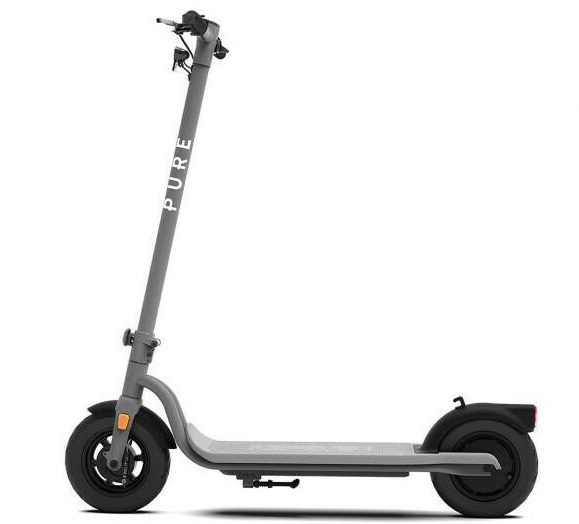
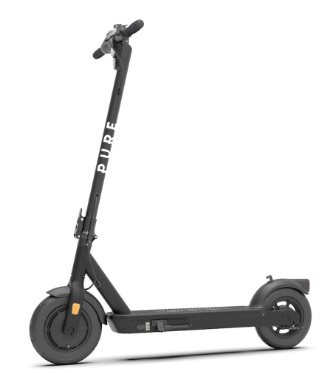
| IP Rating | IP65 |
| Max Speed | 15 mph |
| Power | 250W (Pure Air) 350W (Pure Air Pro) |
| Range | 18.6 miles (Pure Air) 22.4 miles (Pure Air Pro) |
| Brakes | Mechanical on one wheel, electronic brakes on the other |
| Weight | 16.5 kg (Pure Air) 17 kg (Pure Air Pro) |
These two scooters are the first electric scooters by rapidly growing UK electric scooter retailer Pure Electric. With the UK market in mind, water resistance was seen as key for both. They are among the few scooters with an IP65 rating, making them suitable for use in the rain and built for British weather was one of their core selling points.
The Pure Air Pro hit the market first. It is a little more expensive due to its larger battery and power.
The Pure Air is the cheaper follow-up model, and represents the better value overall. It also has some additional features such as Bluetooth
Both scooters come with 10 inch pneumatic tyres and a relatively large frame which helps deliver stability and a smooth ride. The downside of both models is that their size and limited folding compaction makes them less portable than many scooters.
The price point of both scooters makes them the best value entry level electric scooter with enough water resistance to regularly use in the wet. In fact their combination of specification and cost is proving so popular that they compete with the might Xiaomi M365 in the UK market. They even beat the M365 in some areas.
Both models have drum brakes on one wheel and electronic braking on the other. On the Pure Air Pro the motor and electronic brake is on the front, mechanical drum brake on the rear. On the Pure Air it is the other way round. The electronic brake is activated at the same time as the lever is pulled for the mechanical brake, so braking is applied to both wheels. Adequate but not the best overall packaging of brakes.
Click here for a FULL REVIEW and comparison
2. Segway Ninebot MAX
Best water resistant scooter from reliable brand
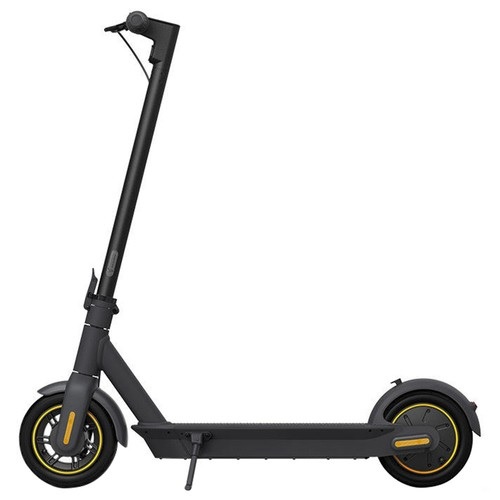
| IP Rating | IPX5 |
| Max Speed | 18 mph (*Restricted to 15 in some locations) |
| Power | 350W |
| Range | 40 miles |
| Brakes | Front mechanical (drum) Rear electric |
| Weight | 18.7 kg |
The Segway Ninebot Max is the quintessential safe choice. Not just as a scooter for use in wet conditions but as a scooter in general. It is made by Ninebot-Segway, the biggest global manufacturer of electric scooters (part owned by bigger brother Xiaomi). The original Segway company was acquired by the Chinese company Ninebot in 2015, which helps explain the confusing and inconsistent names!
The Ninebot Max has the same basic design as the Xiaomi M365, but the Ninebot Max is bigger, more stable and more powerful. It has large 10 inch wheels , a larger frame and deck, a longer range and a more powerful motor. One of the only downsides of this scooter is it’s greater weight and bulky frame makes it less compact for transporting.
So why is this electric scooter suitable for use in wet weather?
It has a rare IPX5 rating. In terms of certification, this means it can withstand “Medium pressure jet – 6.3mm diameter, similar to garden hose – from any angle for 3 minutes”. Whilst that might not mean much, this IPX5 rating is higher than the vast majority of scooters on the market.
Large 10 inch pneumatic tyres, large deck and low centre of gravity combine to give this scooter an excellent reputation for stability. The modest 350W power going to the back wheels means it’s unlikely to slip due to excessive acceleration, yet it has enough power for decent acceleration and maintaining modest speed on up hill climbs.
It has front mechanical drum brakes and electronic regenerative brakes (referred to as KERS or Kinetic Energy Return System) integrated into the rear wheel motor. The ideal set-up would include front and rear mechanical brakes so the braking set-up is not perfect. However, the KERS is adjustable to increase its braking power. Overall, the brakes are adequate on an otherwise excellent scooter.
Read our FULL REVIEW on the Ninebot Max
3. Furo Fuze and Fuze Max
Best balance of specification and water resistance at competitive price
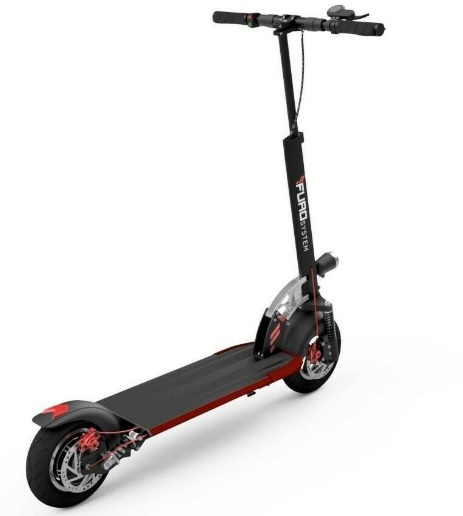
| IP Rating | IP55 |
| Max Speed | 25 mph |
| Power | 500W (800W Peak) |
| Range | 24 / 34 miles |
| Brakes | Front and rear mechanical disc brakes |
| Weight | ~18 kg |
Along with the Furo Fuze IP55 water resistance rating, the company says the scooter is “completely protected from any condition you can expect under outdoor use, from dust to rain and puddles”. The manual does suggest avoiding puddles deeper than 2.5cm / 1 inch. This is understandable for safety reasons as well and avoiding excessive water on the brakes.
The Fuze comes with large 10 inch pneumatic tyres and adjustable suspension, all of which helps deliver a smooth ride and good traction. The scooter also has excellent front and rear mechanical disc brakes as well as regenerative electronic brakes. This combination helps deliver strong and balanced braking, even in wet conditions.
All of these factors that make the Fuze excellent for use in wet conditions, But this scooter is an excellent overall package compared to others on the market. It is sold with a full 2 year warranty by the UK company behind the Fuze, Furo Systems. Do check out our full review.
Read our FULL REVIEW of the Furo Fuze
4. Emove Cruiser
Best overall specification
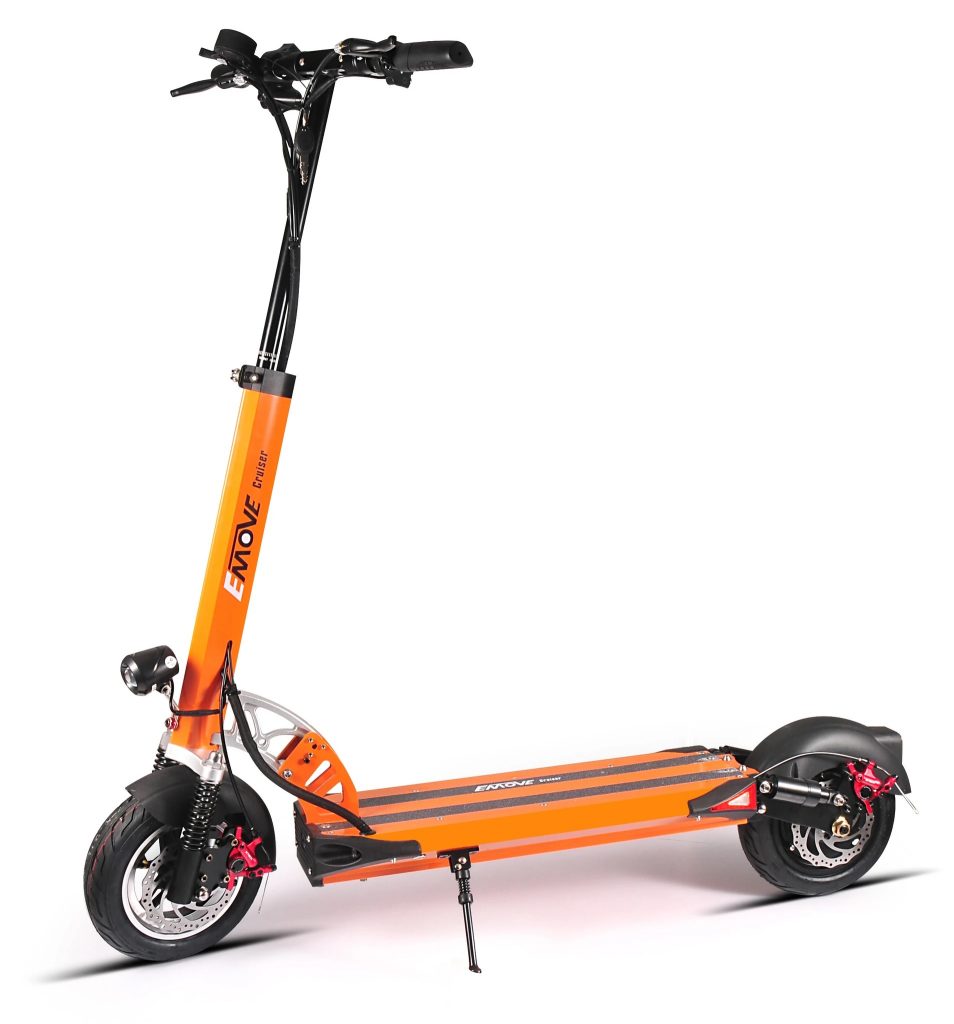
| IP Rating | IP67 |
| Max Speed | 25 mph |
| Power | 600W |
| Range | 62 miles |
| Brakes | Front and rear mechanical (Hybrid hydraulic ) |
| Weight | 23 kg |
The Emove Cruiser has an IP67 water resistance rating. But one thing to be aware of is that whilst this rating is excellent – it is specifically a test for submersion in water. Therefore it does not necessarily cover all conditions of spraying water. The manufacturers do advise to only use in light rain.
The Cruiser is the complete package, for use in most weather and over long or short ranges. Technically this is the only scooter designed to be able to withstand full immersion in water – we don’t recommend this though!
It comes with front and rear mechanical hybrid hydraulic disc brakes (put simply, they are excellent brakes). Having mechanical front and rear brakes provides excellent stopping capabilities. The 10 inch wheels have pneumatic tyres that are also relatively thick (at 2.7 inches wide), providing good traction in the wet. It also has a long and wide deck which is great for stability.
The nominal power of the motor is 600W, yet is can deliver a huge 1,600W maximum output. Whilst this is excellent for hill climbing and acceleration in normal conditions, this level of power could be a hazard in the wet. We recommend using it in one of the lower power modes when wet.
As for the drawbacks, well this specifications does not come cheap. In addition, the Cruiser does have a larger frame and whilst it does fold up nicely it is relatively heavy at 23 kg.
Check out out FULL REVIEW of the Emove Cruiser here
5. 8Tev B12
Distinguished design with super smooth ride
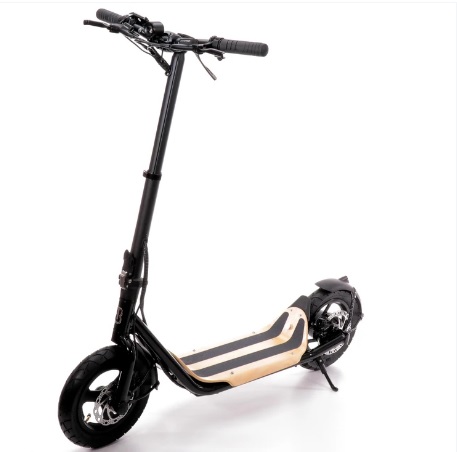
| IP Rating | IPX6 |
| Max Speed | 15.5 mph |
| Power | 250W |
| Range | 19.8 miles (Classic model) |
| Brakes | Front and rear mechanical (Hydraulic disc ) |
| Weight | 17 kg |
The B12 is a premium positioned scooter made by 8Tev. There are three models of the B12, differentiated by their battery sizes. The Classic (mid range version) is our choice.
The B12 has a distinct look and design compared to most electric scooters. It is manufacturer by Italian manufacturer Piaggio, (famous for the iconic Vespa motorcycle brand). Premium credentials include high grade motorcycles materials for its sold frame. It has high quality components throughout, such as magnesium wheels with high-grade Japanese sealed bearings.
But what makes this electric scooter so suitable for wet weather riding?
First of all it has and excellent IPX6 rated water resistant making it’s electric components extremely safe from water ingress.
It has 12 inch pneumatic tyres – this is huge for electric scooters. These extra large wheels inherently help in reducing the impact of all types of road bumps, taking away the need for suspension. Combined with relatively low deck height makes stability and safety one of the core selling points of this scooter.
It has dual piston hydraulic disc brakes enabling assured and quick braking even in the wet. You are unlikely to find better brakes on any electric scooter outside of high speed enthusiast models.
So what of the downsides? This premium scooter comes at a high price. The rock solid components and large wheels are great for ride quality but are a disadvantage when it comes to portability and weight. It also has limited power with a 250W motor.
For it’s target market who want a classy and comfortable ride this scooter stands alone. Its wide deck can easily accommodate the “side by side” riding position (feet next to each other), for those who prefer it. For many it will feel a safer and more stable ride, making it a distinguished scooter with a touch of class.
Quick summary of ingress protection (IP) ratings
IP ratings simply stands for ingress protection. It is a method for rating the level of protection given to electrical components against the ingress of solids and liquid. On electric scooters this refers to the protection provided to electronics and the battery.
By choosing an electric scooter with an IP55 rating or higher, you can be much more confident it will not be damaged by regular use in wet weather.
What does IP54 mean?
IP54 rating means some basic water resistance – but that resistance is limited. According to the specific test procedures, it means it can “resist low pressure spray at any angle for 10 minutes”. IP54 is the most common IP rating for electric scooters. If only occasionally use your scooter in wet conditions, this will probably provide sufficient protection, but it is no guarantee.
It is important to add that two different electric scooters with IP54 ratings may provide a different degree of protection in real world wet conditions. This is because as the certification process only simulates specific water exposure test conditions. These conditions will not mimic all real world scenarios.
Overview of IP ratings in general
Ratings consist of the letters IP followed by two numbers. IP54 rating is the most common rating for electric scooters. The second number (4 in this example) denotes the degree of water protection, the first number (often considered less important) indicates protection against solid objects of different sizes. For example, grains of sand or dust which may interfere with electrical components.
Occasionally ingress protection ratings are written as IPX4, where the X just denotes an absence of a rating for solid ingress. This may indicate the manufacturer has not tested for solid ingress, often because they don’t think it is important or relevant.
A minimum of IPX5 is needed to be confident an electric scooter will be protected from water damage in most outdoor conditions
IPX5 or better is uncommon on electric scooters. Even where it is present some manufacturers still advise against using their products in the wet. There are several explanations for this:
- Ensuring electronics housing is consistently waterproof is will incur additional cost in design, components, manufacturing and quality control
- Getting the tests done costs time and money
- Some manufacturers are keen to discourage use of electric scooters in wet conditions due to other concerns such as safety or corrosion
- Advising against using an electric scooter in the wet keeps the onus of responsibility on the owner, not the manufacturer – this takes away the potential headache of returns and refunds due to water damaged products
For a full explanation of IP ratings see our article here.
What is the difference between IPX4 and IPX5?
According to the IP rating system, IPX4 means it can resist “low pressure spray at a any angle for 10 minutes”. Whereas IPX5 means it can withstand “medium pressure jet – 6.3mm diameter, similar to garden hose – from any angle for at least 3 minutes”.
So the key differences is IPX5 can withstand water jet at higher pressure than IPX4. This is still not a guarantee of preventing water ingress but it is an important improvement.
Can IP54 rated scooters offer sufficient water protection?
In some cases, there is enough information on the robustness of select electric scooters to be confident that despite their official rating of IP54, they may actually perform well in real world conditions. The Xiaomi M365 scooter is a good example of this. It is rare for water ingress to be reported as a cause of issues on this scooter despite many owners ignoring warnings and riding it in wet conditions. Again, this is absolutely no guarantee it will not be damaged from riding in the wet, but this does help inform the level of risk.
Just be aware that the risk is on you. Use of and IP54 rated electric scooter in wet conditions is likely to invalidate the warranty and water damage will not be covered. Like all things it is a calculated risk.
Also remember, not all IP54 rated electric scooters have exactly the same level of real world water resistance.
Which electric scooters are waterproof?
For an electric scooter to be considered truly waterproof it would need to be protected under water. Understandably, few electric scooters have been built to this standard. However, an IP rating of IP55 or higher is widely considered to be sufficient water resistance to effectively be described as “waterproof”, or at least suitable for riding in wet conditions. To be considered waterproof from submersion in water requires a IPX7 rating. However, this rating does not necessarily mean that it has been tested against spray or water jets (like the “lower” ingress protection ratings).
There are not many electric scooters with an IP rating of IPX5 or greater. You can be confident that those with such a rating will have undergone more stringent testing and been built with water resistance as a priority.
Safe use of electric scooter in wet conditions
In addition to ingress protection rating, there are other factors to consider when buying or using an electric scooter in wet conditions. These relate to both scooter durability as well as safety.
Riding style for wet conditions
Above all else, the most obvious precaution that can be taken when riding any electric scooter in wet conditions is to adjust how you ride . Ride slower and less aggressively. Take corners cautiously and slowly. Brake early.
Choice of brakes for riding in the wet
Key Message: Know the characteristics of your brakes in wet and dry conditions. The ideal is to have is front and rear mechanical brakes with additional electric braking (from the motor)
Increased breaking distance is inevitable in wet conditions. But some scooters will perform better than others.
Mechanical brakes refer to those which utilise a lever on the handlebars and an associated mechanical braking mechanism. That may be disc brakes, drum brakes or hydraulic brakes. There is varying preference towards different types of brakes. The ideal set-up would include mechanical brakes on both front and rear wheels.
There is often debate about which type of mechanical brake are better. Ultimately if they are adjusted properly all of them should provide sufficient braking force to stop the wheel. However, they can vary in how sensitive they are. This is mainly a question of preference and adjustment to braking characteristics. Brake adjustment can impact these characteristics to some extent. The bottom line is test your brakes in wet and dry conditions and become familiar with how they respond and the force you need to apply.
Having both front and rear mechanical brakes can help you slow more quickly without skidding, because the braking force is spread over two wheels, and two contact points with the road.
Electric brakes in the wet
Key Message: Electronic brakes are good supplement to mechanical brakes, but not sufficient for emergency braking
Electric brakes are very a common on electric scooters. They essentially use the electric motor to slow the wheel. They may be applied automatically (when the throttle is not applied), by a specific electronic brake lever, or be incorporated into the braking when an a mechanical brake lever is pulled. It is also common for some scooters to try and harness some of this energy to charge the battery (often referred to as regenerative braking, or KERS which is short for Kinetic Energy Return System).
Electric brakes are often considered inferior to mechanical brakes because they do not apply as much braking force. However, in wet conditions a gentle cautious riding style of regular soft braking can actually be well suited to the use of electric brakes. The advantage is that electric brakes avoid the risk of locking the wheels and skidding. The added benefit of a riding style which uses electronic braking it reduces wear of components in mechanical brakes.
Some Xiaomi scooters claim to have Electronic ABS. It’s true that the brakes it will not cause a wheel to lock-up upon braking. But it is not the same system as ABS on cars and provides less powerful braking. This wording is mainly marketing spin on a form of braking already prevalent in many electric scooters.
Alas, true ABS technology has not yet been adopted on electric scooters only be a matter of time. Particularly as safety becomes an increasing factor as electric scooters become more widespread.
Electric scooter tyres for use in the wet
Key Message: Wide pneumatic tyres will have the most traction are best
Pneumatic wheels have more traction than solid. Wider wheels also have greater contact force which will also help deliver more traction. Both of these will means that skidding is less likely when braking, accelerating or turning corners.
There are options for different tyre treads depending on scooters, although we are not looking in detail at these options. Electric scooter tyres typically have some tread to be a compromise enabling use in both wet and dry conditions.
Riding off road is will require much more consideration of tyre tread. The tread will need to match the type of off road surfaces you are riding on. Here we are primarily referring to scooters for urban and commuter riding.
Riding high power or fast electric scooters in the wet
Key Message: Be cautious when riding electric scooters in the wet with motors over 500W – if you want a high power scooter for use in the wet, consider dual motor or simply switch to slower mode in wet conditions
Most people welcome more power and speed. But when it comes to riding in the wet it is important to be extra cautious of higher powered scooters. Although technically it is the maximum torque that is important here, motor power is a reasonable approximation. Scooters below 500W should be fine, but 500W and up the increased acceleration can increase likelihood of loosing traction. High power scooters with greater torque and acceleration can pose greater risks in the wet.
Avoid applying the accelerator when turning. On a low traction surface like wet leaves this can presents a serious risk of loosing traction. I have personal experience from this on specific parts of regular journeys. I know it is safe to accelerate on a low power scooter, but when I accelerate at the same spot on a higher power scooter the back end slides.
Dual motor scooters have an advantage here as they spread the power over both wheels.
Electric scooters with ABS or traction control? Alas, this is not a feature on any electric scooters…yet.
Preventing corrosion
Key Message: Store your scooter in a cool dry place
Component quality can be harder to decipher when you buy an electric scooter. Particularly as it is usually the smaller components such as nuts and bolts that can be susceptible to rust, rather than components like the deck or stem. Generally component quality and rust resistance is something that increases with scooter price, but this is not always the case.
Particular attention needs to be taken when looking after electric scooters with suspension. It may be susceptible to water ingress and subsequent corrosion in a way that the electrical components are not. This will not cause catastrophic failure but could reduce the performance of the suspension, making it less smooth and noisy. Check the user manual for maintenance advice. We plan on looking at taking care of electric scooter suspension in a separate article.
Questions about using electric scooters in the wet
Can you use electric scooters in the rain?
This answer depends upon a few factors. Firstly the scooter IP rating. We would recommend a minimum rating of IP55 / IPX5 to use in the rain with some confidence. Unfortunately most electric scooters have a lower rating than this, usually IP54. In this case we would recommend avoiding prolonged use in the wet. Each the individual scooter manufacturer will have guidance for use in the wet which tends to be on the cautious side.
Ultimately the decision relies on the rider to making a sensible judgement on the specific scenario. Occasional use in light rain is very different to regular extended use in heavy rain. In truth, most electric scooters with an IP54 rating will survive occasional use in wet conditions, even though manufacturers typically advise against it. The popular Xiaomi M365 is IP54 rated and the manufacture does not recommend it is used in the wet. However, there are few reports of issues from water ingress despite widespread use of this scooter in the wet. Just be aware that damaged caused this will probably not be covered by your warranty.
How do i make my electric scooter waterproof?
Some people have reported using silicone sealants (similar to those used in bathrooms) to help make their electric scooter waterproof. This strategy may help reduce risk of water damage in some cases. However, it does require knowledge of the areas most susceptible to water ingress which is not always obvious. It is a reasonable strategy to reduce risk of water damage but certainly no guarantee.
There may be specific advice associated with individual scooter models on how to modify the scooter to improve water resistance. However, this is also no guarantee of protection. If you do plan on using your electric scooter in the wet, you should at the very least look for one with an IPX4 rating, but ideally one with an IPX5 or higher.
Can you wash an electric scooter?
You certainly can wash an electric scooter. But the amount of water you can expose the scooter to depends on its IP rating. If the scooter does not have an IP rating, it is recommended to just use a wet cloth. If it has a IP rating of IP54 or IP55, it should be able to withstand some limited low pressure water (for example to wet or rinse certain parts). If it has a rating of IP56 or higher, it should be able to withstand gentle spray from a hose.
The other factor to consider is the part of the scooter being washed. If it is nowhere near electrical components then you can be less cautious. Just be aware that if the brakes have become wet during washing, this may significantly impact braking performance until they dry.
How do I store my electric scooter for winter?
Electric scooters should be stored in sheltered dry conditions. Exact storage location depends on the climate where you live, but in most countries a garage, garden shed, store cupboard or basement would be ideal. Electric scooters usually fold up sufficiently small to be suitable for storing in smaller outdoor storage
Ideal temperature for storing a lithium-ion battery (the battery found in the majority of electric scooters) is 15 °C / 59 °F (the temperature of a cool indoor room). However, these batteries are relatively tolerant of much lower storage temperatures (down to -20 °C), but should not be stored in high temperature places (ideally no higher than 25 °C).